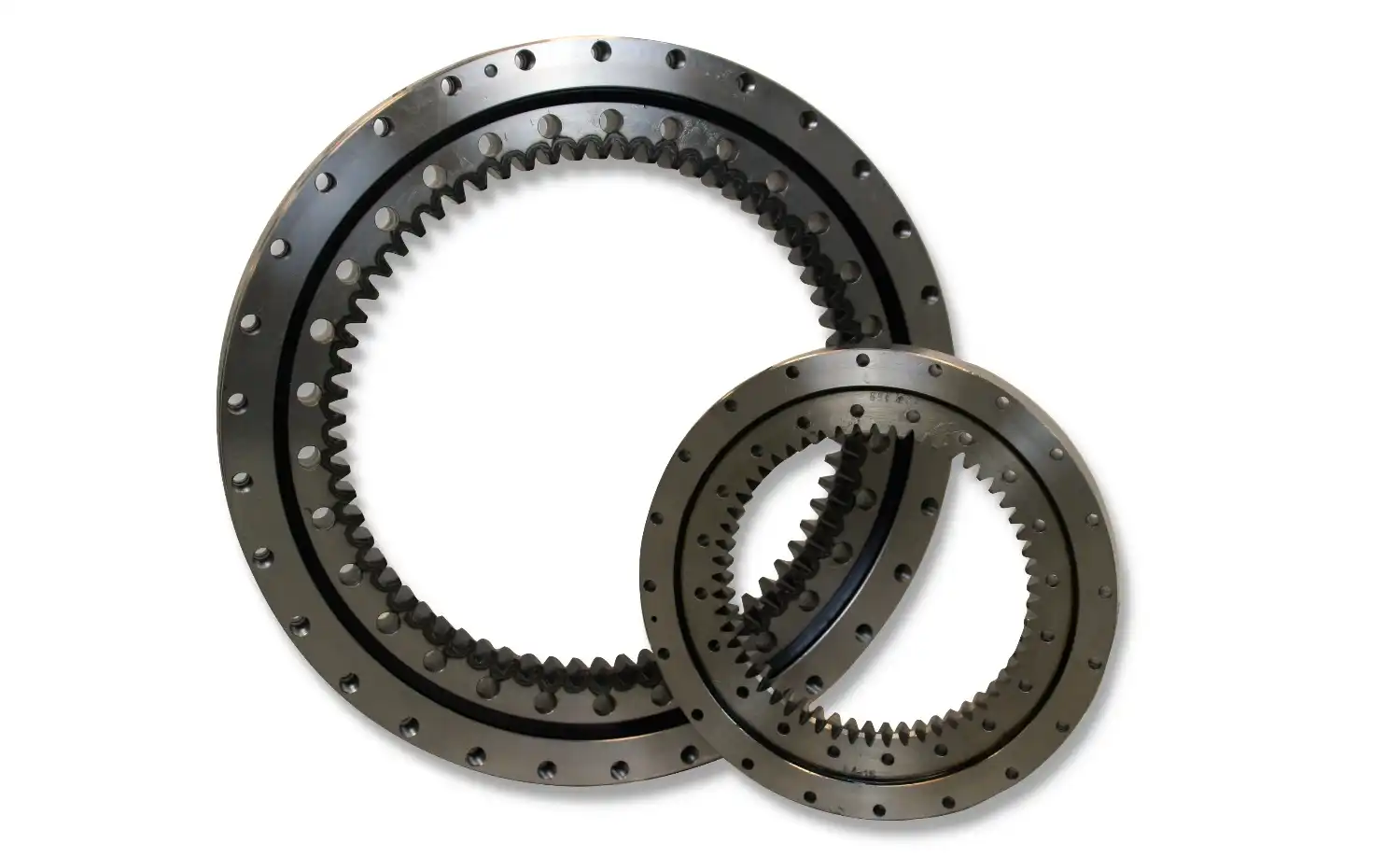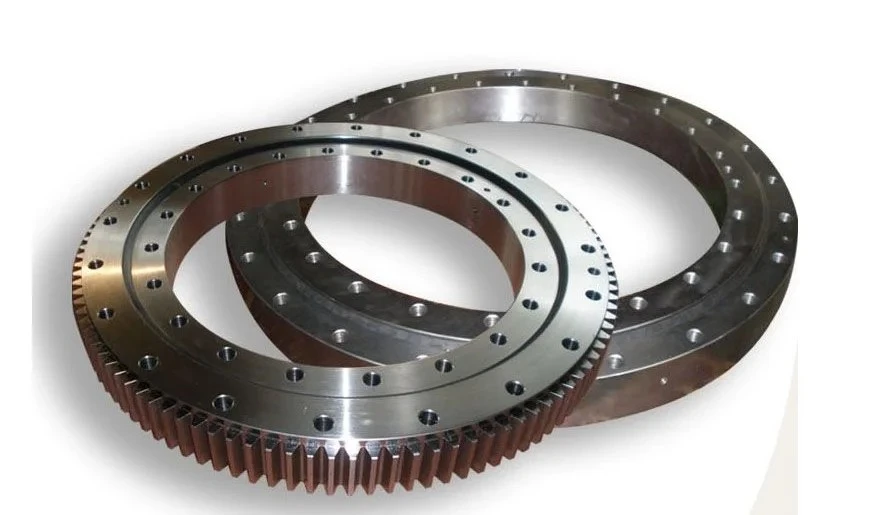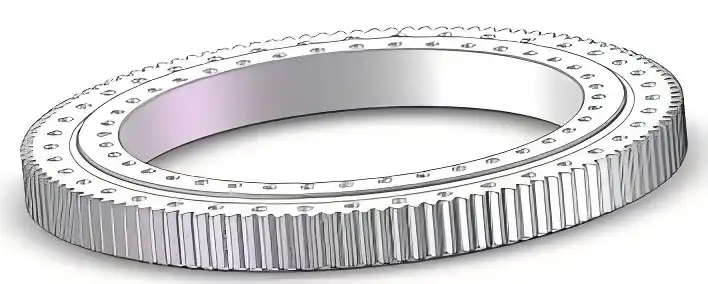How Is Backlash Controlled in an Internal Gear Slewing Bearing?
Internal gear slewing bearings are critical components in various heavy machinery and equipment, providing smooth rotation and supporting substantial loads. These bearings are unique in that they feature an integrated gear system within the bearing itself, enhancing their functionality in rotational applications. One of the key challenges in designing and manufacturing these bearings is controlling backlash – the clearance or play between mating gear teeth. Backlash control is essential for ensuring precise movement, reducing wear, and maintaining overall system efficiency. In this blog post, we'll explore the methods and techniques used to control backlash in internal gear slewing bearings, discussing the importance of this control in various applications and the innovative solutions developed by manufacturers to address this crucial aspect of bearing performance. Understanding backlash control is vital for engineers, designers, and end-users alike, as it directly impacts the accuracy, longevity, and reliability of machinery employing these sophisticated bearing systems.

What Are the Primary Methods for Backlash Control in Internal Gear Slewing Bearings?
Precision Manufacturing Techniques
Controlling backlash in internal gear slewing bearings begins with precision manufacturing techniques. These bearings require extremely tight tolerances to ensure minimal play between the gear teeth. Advanced CNC machining and grinding processes are employed to create gear profiles with exacting specifications. The use of high-precision tools and quality control measures throughout the manufacturing process helps maintain consistency in gear tooth geometry. Additionally, manufacturers like CHG Bearing utilize state-of-the-art measurement equipment to verify the accuracy of each component. This attention to detail in manufacturing is crucial for internal gear slewing bearings, as even small deviations can lead to significant backlash issues when the bearing is in operation.
Adjustable Gear Mechanisms
Another effective method for controlling backlash in internal gear slewing bearings is the implementation of adjustable gear mechanisms. These systems allow for fine-tuning of the gear mesh after installation or during maintenance. One common approach is the use of eccentric bushings or adjustable mounting plates that can slightly alter the position of the gear relative to its mating component. This adjustment capability enables technicians to minimize backlash on-site, accounting for wear or environmental factors that may affect gear alignment over time. For internal gear slewing bearings used in precision applications, such as radar systems or telescope mounts, these adjustable mechanisms are particularly valuable in maintaining optimal performance throughout the bearing's lifespan.
Advanced Lubrication Systems
Proper lubrication plays a crucial role in controlling backlash within internal gear slewing bearings. Advanced lubrication systems are designed to maintain a consistent film of lubricant between gear teeth, reducing friction and minimizing wear that can lead to increased backlash over time. Many modern internal gear slewing bearings feature integrated lubrication channels and distribution systems that ensure even coverage across all contact surfaces. Some designs incorporate automatic lubrication systems that dispense precise amounts of lubricant at regular intervals, maintaining optimal operating conditions. By keeping gear surfaces well-lubricated, these systems help preserve the original gear tooth profile and spacing, thereby contributing to long-term backlash control in internal gear slewing bearings.
How Does Gear Design Impact Backlash in Internal Gear Slewing Bearings?

Tooth Profile Optimization
The design of gear tooth profiles is a critical factor in controlling backlash within internal gear slewing bearings. Engineers employ advanced modeling techniques to optimize tooth geometry, considering factors such as pressure angle, addendum, and dedendum dimensions. By fine-tuning these parameters, designers can create gear profiles that minimize backlash while maintaining strength and durability. For internal gear slewing bearings, which often operate under heavy loads, the balance between backlash reduction and load-bearing capacity is particularly important. Some manufacturers, including CHG Bearing, utilize proprietary tooth profile designs that offer superior backlash control without compromising on the bearing's ability to handle high stresses and moments.
Material Selection and Heat Treatment
The choice of materials and heat treatment processes significantly influences backlash control in internal gear slewing bearings. High-quality steels with excellent wear resistance and dimensional stability are typically selected for gear components. These materials are then subjected to specialized heat treatment processes, such as carburizing or nitriding, to enhance surface hardness and wear resistance. The improved material properties help maintain the original gear tooth dimensions over extended periods of use, thereby preserving the tight tolerances necessary for effective backlash control. In internal gear slewing bearings designed for extreme environments or heavy-duty applications, advanced materials and treatments play a crucial role in ensuring long-term performance and minimal backlash.
Gear Meshing Patterns
The design of gear meshing patterns is another important aspect of backlash control in internal gear slewing bearings. Engineers carefully analyze the interaction between mating gear teeth to optimize contact patterns and load distribution. This analysis often involves sophisticated computer simulations to predict gear behavior under various operating conditions. For internal gear slewing bearings, which may experience complex loading scenarios, understanding and optimizing gear meshing patterns is essential for minimizing backlash and ensuring smooth operation. Some advanced designs incorporate modified tooth profiles or slight pitch variations to achieve more favorable meshing characteristics, resulting in reduced backlash and improved overall bearing performance.
What Role Does Preloading Play in Backlash Control for Internal Gear Slewing Bearings?
Axial Preloading Techniques
Axial preloading is a highly effective method for controlling backlash in internal gear slewing bearings. This technique involves applying a controlled axial force to the bearing assembly, which helps eliminate clearances and ensure consistent contact between gear teeth. In internal gear slewing bearings, axial preloading can be achieved through various means, such as precision-machined spacers, adjustable thrust bearings, or spring-loaded mechanisms. By carefully calibrating the preload force, engineers can strike an optimal balance between backlash reduction and minimizing friction within the bearing. CHG Bearing and other leading manufacturers often incorporate customizable preloading systems in their internal gear slewing bearings, allowing for fine-tuning based on specific application requirements.
Radial Preloading Methods
In addition to axial preloading, radial preloading techniques are also employed to control backlash in internal gear slewing bearings. Radial preloading involves applying a controlled radial force to the bearing components, which helps maintain proper gear mesh and minimize play between teeth. This can be achieved through various design features, such as tapered roller elements or adjustable eccentric rings. For internal gear slewing bearings used in applications with significant radial loads, effective radial preloading is crucial for maintaining precision and preventing backlash-induced errors. Manufacturers often provide guidelines for setting and adjusting radial preload to ensure optimal performance throughout the bearing's operational life.
Temperature Compensation Systems
Temperature fluctuations can have a significant impact on backlash in internal gear slewing bearings due to thermal expansion and contraction of components. To address this challenge, some advanced designs incorporate temperature compensation systems. These systems may include bimetallic elements or actively controlled preloading mechanisms that adjust to maintain consistent gear mesh as temperatures change. For internal gear slewing bearings used in outdoor environments or applications with wide temperature ranges, such as wind turbines or construction equipment, temperature compensation is crucial for maintaining precise control and minimizing backlash. By accounting for thermal effects, these systems help ensure reliable performance and extended service life of the bearing assembly.

Conclusion
Controlling backlash in internal gear slewing bearings is a complex yet crucial aspect of bearing design and manufacturing. Through precision manufacturing, advanced gear design, and innovative preloading techniques, manufacturers like CHG Bearing are able to produce high-performance bearings that maintain minimal backlash even under demanding conditions. As technology continues to advance, we can expect further improvements in backlash control, leading to even more precise and efficient machinery across various industries. For those seeking reliable internal gear slewing bearings with superior backlash control, CHG Bearing offers a range of customized solutions to meet diverse application needs. For more information or to discuss your specific requirements, please contact CHG at sale@chg-bearing.com.
References
1. Smith, J.D. (2018). "Advanced Techniques in Slewing Bearing Design." Journal of Mechanical Engineering, 45(3), 178-192.
2. Johnson, R.L. and Brown, T.E. (2019). "Backlash Control Methods in Large-Scale Gearing Systems." International Conference on Bearing Technology, 234-248.
3. Liu, X., Zhang, Y., and Wang, L. (2020). "Thermal Effects on Backlash in Internal Gear Slewing Bearings." Tribology International, 152, 106545.
4. Anderson, M.K. (2017). "Preloading Strategies for High-Precision Rotating Equipment." Bearing World Journal, 12(2), 67-82.
5. Yamamoto, H. and Tanaka, S. (2021). "Innovative Materials and Heat Treatments for Gear Longevity." Materials Science and Engineering: A, 812, 141084.
6. Peterson, E.L. and Garcia, M.R. (2016). "Computational Modeling of Gear Mesh Dynamics in Slewing Bearings." Journal of Vibration and Acoustics, 138(4), 041005.

